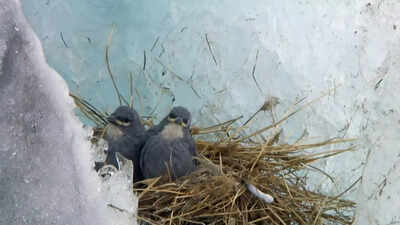ARTICLE AD BOX

The Glacier Finch, also known as the White-winged Diuca Finch, is one of nature’s most extraordinary birds, fascinating ornithologists and wildlife enthusiasts alike. Native to the Andes mountains of South America, this tiny bird survives at altitudes exceeding 4,000 metres, where oxygen is scarce and temperatures plunge well below freezing.
What sets it apart is its remarkable nesting behaviour: it builds its nests directly on glaciers, braving icy surfaces and relentless cold to incubate eggs and raise chicks. Scientists believe this unusual strategy may provide protection from predators and aid thermoregulation. The Glacier Finch exemplifies high-altitude adaptation, demonstrating how life can persist and thrive in some of the planet’s harshest and most unforgiving environments.
Glacier finch: High-altitude survival and unique ice nesting
The Glacier Finch inhabits the Andes mountains, spanning countries like Chile, Argentina, Bolivia, and Peru. These regions are characterised by towering peaks, scarce vegetation, and oxygen levels significantly lower than at sea level. Despite these harsh conditions, the finch has evolved physiological and behavioural adaptations, allowing it to survive where few other birds can. Its high-altitude lifestyle makes it one of the most resilient species in South America’s mountainous ecosystems.
What makes the Glacier Finch truly exceptional is its ice nesting behaviour. It is the only known bird species that builds its nest directly on glacial ice. This nesting strategy, seemingly counterintuitive, provides unique advantages. Nesting on ice reduces the risk of predation, as most ground-based predators avoid glaciers. Additionally, the reflective surface of the ice may help regulate temperature, preventing eggs from overheating in the limited high-altitude sun while offering insulation from extreme cold.
Glacier finch ice nesting: Predator protection, thermoregulation, and extreme survival
Scientists remain puzzled about why Glacier Finches favour ice over other surfaces. Hypotheses suggest predator protection, as glaciers are largely inaccessible to foxes and other mammals. Another theory highlights thermoregulation, where nests on ice maintain a stable microclimate despite fluctuating temperatures. Despite the controversy, what is clear is that this unusual behaviour enables the finches to reproduce successfully under conditions that would challenge most bird species.Surviving in icy temperatures above 4,000 metres requires incredible adaptation. The Glacier Finch has developed robust survival strategies, including building nests in sheltered ice depressions and lining them with insulating materials. Even during severe cold snaps, the finches incubate eggs and care for chicks with remarkable efficiency, demonstrating nature’s ingenuity in extreme environments.
Glacier finch diet and insulating nest adaptations for high-altitude survival
The finch’s diet is specially adapted to the thin alpine vegetation of the Andes.
It primarily feeds on seeds from hardy mountain plants and small insects, making it an opportunistic feeder. Its ability to extract nutrition from scarce resources is essential for survival in high-altitude ecosystems, where food is limited and seasonal availability varies greatly.Although their nests are built on solid ice, Glacier Finches line them with feathers, moss, and grass to protect the eggs and chicks from freezing conditions.
This combination of natural insulation and careful nest placement ensures the survival of the young during the early, most vulnerable stages of life. The ingenuity of these tiny builders highlights a remarkable example of behavioural adaptation in birds.
Glacier finch and climate change: Threats to survival and remarkable resilience
The Glacier Finch faces a growing threat from climate change. Rapid glacier melting is shrinking the available nesting habitats, endangering both reproduction and long-term survival.
As ice retreats, these high-altitude birds may struggle to find suitable nesting sites, making them increasingly vulnerable to population decline. Conservation efforts in the Andes are critical to protect these fragile ecosystems and preserve the species that depend on them.The Glacier Finch remains one of nature’s most captivating high-altitude birds. Its ability to breed and raise chicks on glaciers demonstrates extraordinary adaptation, resilience, and ingenuity. Despite the harshness of its environment and the looming threat of climate change, the Glacier Finch continues to survive, offering a remarkable example of how life can persist in the most extreme corners of our planet.Also Read | Meet Australia’s geckos: Tiny lizards that can see 350 times better at night; key traits, habitat, survival and more

 3 hours ago
3
3 hours ago
3









 English (US) ·
English (US) ·